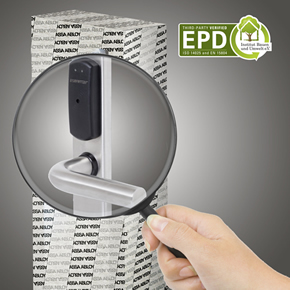
Not every Environmental Product Declaration is created equal
Charles Robinson, Sustainability Manager at ASSA ABLOY Group, examines how better product EPDs can help us design more sustainable buildings.
Sustainability in our buildings matters, right? It no longer seems controversial or especially radical to write that. Alongside the environmental concerns, sustainable buildings are often cheaper to run, easier to let and more attractive to investors. But one day we may view persuading users about the importance of sustainability as the easy battle. Because we’re left with a trickier problem: how can we measure it?
Commercial construction is complex. Its vast web of inputs touch so many areas that sustainability must address, from energy, materials and land use to water, waste and pollution. If our goal is to award buildings a sustainability rating that’s as easy to understand as the one for a washing machine, we still have some way to go. What we need to get there, more than anything, is information. Lots of it; authoritative, detailed and properly audited — so architects can design buildings from the earliest stages to sustainability criteria laid down by LEED, BREEAM and others.
This is where the Environmental Product Declaration, or EPD, comes in.
EPD: Environmental Product Declaration
What exactly is an EPD? It is a document detailing a product’s impact during its complete life cycle. It isn’t a proof of environmental credentials per se, but a map of the product footprint, from raw material, through manufacturing, logistics and impact during use, to end-of-life recycling. So-called ‘generic’ EPDs assess the footprint of a typical product of a certain type; a typical electric oven, say, or a typical electronic lock.
However, products validated by a generic EPD can be manufactured anywhere, with a multitude of components, finishes, dimensions and so on. A generic EPD only gives a loose indication of environmental impact. They are useful, certainly, as an impression of the landscape.
A ‘product-specific’ EPD, on the other hand, is like an Ordnance Survey map.
These supercharged EPDs detail precise environmental impact based on a unique bill of materials. They are time-consuming to create, involving a complete life-cycle study of a single product, manufactured in a specific way. In LEED, BREEAM and similar certifications, a product-specific EPD can be worth twice as many credits as its generic counterpart. Why? Because it gives architects the tools to make an informed choice. Without this kind of detail, it’s impossible to accurately assess environmental performance.
SMARTair
Take an example from my own company. The EPD for our SMARTair wireless knob cylinder details everything from the embodied carbon of the complete product and impact of carton and foam packaging, to the recycling potential of its steel and zinc content, among much, much more. It runs to 9 detailed pages.
Information documented by this EPD was used in the design of Tower 185, a recent 200m-high addition to the Frankfurt skyline. Tower 185 was one of the first European high-rises to be awarded Gold LEED Certification from the US Green Building Council. It also received a Gold Certificate from the German Sustainable Building Council (DGNB). To date, almost 100 double-knob SMARTair cylinders and wall readers have been fitted at the building.
Our SMARTair locks made another important contribution to this building’s sustainability credentials. Because SMARTair locks are wireless, they consume less energy and so emit less CO2 than standard wired electronic locks.
Across our group, we’ve now published 250+ product-specific EPDs, covering mechanical locksets, cylinders, door closers, floor springs, multi-point locks, doors, handles, hinges, and mechatronic and many other access control solutions. Our EPDs are independently researched by a third party, and then predominately verified by the Institut Bauen und Umwelt (IBU) in Germany.
Creating a mass of trustworthy EPDs has required major investment, of course. It demands adherence to comprehensive standards — in our case, ISO 14025 and EN 15804, which are recognised by LEED and BREEAM. Meeting these standards ensures environmental performance can be compared fairly across products and manufacturers, a critical factor for both design and procurement.
Armed with a product-specific EPD, architects and builders can work with clients to create genuinely sustainable buildings. They can more easily meet the increasing compliance requirements around sustainability. Indeed, if building sustainability ratings are ever to become as easy to understand as food labels, the product-specific EPD is a critical ingredient in the recipe.
ASSA ABLOY,
School Street,
Willenhall,
West Midlands,
WV13 3PW
United Kingdom
Tel: +44 (0)845 071 0882
Visit Supplier's page
Latest news

17th April 2025
Nuaire shares expertise at Specifi Mechanical Services events in 2025
Indoor air quality and ventilation manufacturing specialist Nuaire is pleased to be exhibiting at the Specifi Mechanical Services events once again in 2025.
Posted in Air Conditioning, Articles, Building Industry Events, Building Industry News, Building Products & Structures, Building Services, Exhibitions and Conferences, Facility Management & Building Services, Heating, Ventilation and Air Conditioning - HVAC, Restoration & Refurbishment, Retrofit & Renovation
15th April 2025
West Fraser: CaberDek earns top marks from Home Counties carpentry specialist
A specialist carpentry sub-contractor covering housing sites across a large swathe of the Home Counties has come to value CaberDek from the West Fraser range for a variety of reasons: not least because the high quality panel product doesn’t destroy his operatives’ electric saws!
Posted in Articles, Building Industry News, Building Products & Structures, Building Systems, Case Studies, Restoration & Refurbishment, Retrofit & Renovation, Roofs, Timber Buildings and Timber Products, Wooden products
15th April 2025
GEZE: The Role of Access Control Systems in Enhancing Building Safety
Jane Elvins, Specification and Business Development Manager at GEZE UK, delves into the role of access control systems in enhancing building safety…
Posted in Access Control & Door Entry Systems, Architectural Ironmongery, Articles, Building Industry News, Building Products & Structures, Building Services, Doors, Facility Management & Building Services, Health & Safety, Restoration & Refurbishment, Retrofit & Renovation, Security and Fire Protection
11th April 2025
Don’t Do a Dave! It’s Time to Lock FIT Show 2025 in Your Calendar!
It’s that time again – FIT Show is back! You could be forgiven for thinking there won’t be much new to see when FIT Show returns to the NEC from 29 April – 1 May. Wrong!
Posted in Articles, Building Industry Events, Building Industry News, Building Products & Structures, Building Services, Continuing Professional Development (CPD's), Exhibitions and Conferences, Information Technology, Innovations & New Products, Restoration & Refurbishment, Retrofit & Renovation, Seminars, Training
 Sign up:
Sign up: